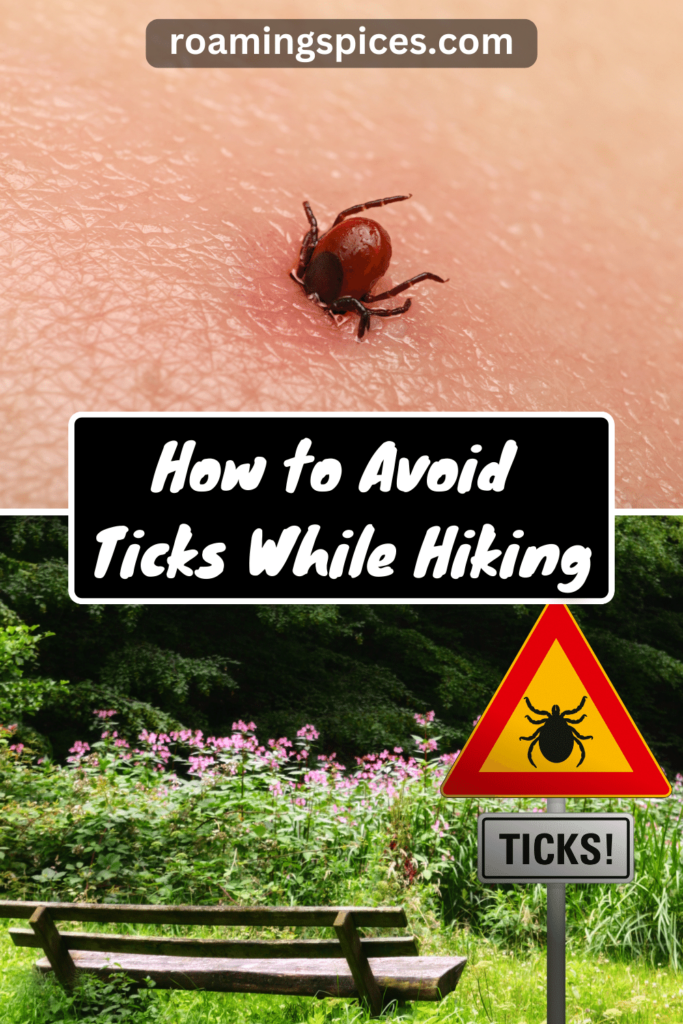
Hiking Tips
Hiking enthusiasts looking to enjoy the great outdoors without worrying about tick encounters can find essential tips on how to avoid ticks while hiking. From proper clothing choices to effective repellents, safeguarding your outdoor adventures has never been easier
Helping You to Avoid Ticks While Hiking
Exploring the great outdoors and embarking on exhilarating hikes is a favourite pastime for many, but the unwelcome presence of ticks can turn an enjoyable adventure into a health risk.
Ticks are tiny arachnids that can transmit various diseases, making tick prevention a crucial part of any outdoor excursion. This article explores essential strategies and tips on how to avoid ticks while hiking.
Whether you’re a seasoned hiker or a beginner, understanding the best practices for tick avoidance will protect you from potential health threats and ensure you can fully savour the natural beauty of the wilderness.
From clothing choices to repellents and smart hiking habits, this guide will equip you with the knowledge and tools to stay tick-free and enjoy your hiking adventures with peace of mind.
Understanding the Tick Threat
Understanding the tick threat when hiking is crucial for outdoor enthusiasts. Ticks, tiny arachnids that feed on the blood of animals and humans, can transmit diseases like Lyme disease and Rocky Mountain spotted fever. To ensure a safe and enjoyable hiking experience, knowing how to avoid ticks while hiking is essential.
Ticks are often found in wooded areas, tall grasses, and shrubs, so hikers should stick to the trail’s centre and avoid brushing against vegetation.
Wearing long-sleeved shirts, trousers, and closed-toe shoes can be a barrier against ticks. Additionally, using tick repellent on exposed skin and clothing is highly recommended.
After your hike, conduct a thorough tick check, paying close attention to hidden areas like the hairline, behind the ears, and under clothing. If you find a tick, remove it with fine-tipped tweezers and disinfect the bite site.
Staying vigilant about ticks and practising these preventive measures can help ensure your hiking adventures are enjoyable and tick-free.
Tick Species and Their Habits
Ticks are arachnid parasites known for their diverse species and varied habits. These blood-feeding ectoparasites can be found in different environments worldwide, from forests and grasslands to urban areas. Here are some of the common tick species:
Black-Legged (Deer) Tick (Ixodes scapularis): Found in North America, these ticks are notorious for transmitting Lyme disease. They inhabit wooded areas and tall grasses, often attaching to deer and rodents.
American Dog Tick (Dermacentor variabilis): These ticks infest dogs and other mammals and are prevalent in the United States. They dwell in grassy areas and may transmit diseases like Rocky Mountain spotted fever.
Lone Star Ticks (Amblyomma americanum): Native to the southeastern United States, these ticks have a distinctive white spot on the female’s back. They feed on various hosts, including humans, and can transmit diseases such as ehrlichiosis and tularemia.
Brown Dog Ticks (Rhipicephalus sanguineus): These ticks primarily infest dogs but can also be found indoors. They are known carriers of various diseases.
Castor Bean Tick (Ixodes Ricinus): Common in Europe, these ticks inhabit wooded areas and can transmit Lyme disease and other pathogens to humans.
Tick habits involve questing, waiting on vegetation for a host to pass by, and blood-feeding to nourish their life stages. Understanding these habits is crucial for tick-borne disease prevention and control, including proper tick removal techniques and protection measures in tick-prone areas.
Dressing Smart: Tick-Resistant Clothing
Dressing smart isn’t just about looking good; it’s also about safeguarding your health, especially in outdoor settings. Tick-resistant clothing has emerged as an essential component of this smart dressing strategy, particularly in regions where ticks are prevalent.
These tiny arachnids can transmit diseases like Lyme disease, making protection a priority for those who love the great outdoors.
Tick-resistant clothing is designed with specially treated fabrics that repel ticks, preventing them from latching onto your skin. The technology behind these garments varies, from insect-repelling coatings to tightly woven fabrics that create a physical barrier.
Whether hiking, camping, or gardening, wearing tick-resistant clothing reduces your risk of tick bites.
Beyond its protective benefits, tick-resistant clothing offers comfort and style, making it a wise investment for anyone in tick-prone areas. With fashion-forward designs and breathable materials, these garments allow you to enjoy nature without compromising your safety or style.
So, dressing smart now means looking good and ensuring your well-being in the great outdoors.
Tick Repellents: What Works Best
Hiking is a beloved outdoor activity, but encountering ticks can quickly turn a pleasant adventure into a health risk. To enjoy the trails without worrying about these tiny pests, understanding which tick repellents work best is essential for anyone wondering how to avoid ticks while hiking.
There are several effective tick-repellent options available. DEET, a common ingredient in insect repellents, is proven to deter ticks. Alternatively, picaridin and permethrin-based products can also offer excellent protection. When hiking, applying these repellents on exposed skin and clothing is advisable, creating a barrier against ticks.
Moreover, consider wearing long-sleeved clothing and tucking trousers into socks to reduce tick access. Light-coloured attire helps spot ticks more easily. Frequent tick checks during and after hikes are crucial, as early removal can prevent potential infections.
In summary, when it comes to how to avoid ticks while hiking, a combination of effective tick repellents, appropriate clothing, and vigilant checks is the key to a worry-free and enjoyable outdoor experience.
Hiking Techniques for Tick Avoidance
Hiking is a beautiful way to connect with nature and stay active, but encountering ticks can spoil your adventure. Avoiding ticks while hiking is crucial for a safe and enjoyable experience.
First and foremost, choose your attire wisely. Wearing long-sleeved shirts, long trousers, and high socks can create a physical barrier against ticks. Tuck your trousers into your socks to seal any potential entry points. Opt for light-coloured clothing to spot ticks more easily.
Another essential technique is using tick-repellent products. Apply an EPA-approved insect repellent on exposed skin and clothing to deter ticks from latching onto you.
Stay on marked trails and avoid tall grass, where ticks often lurk. After your hike, thoroughly inspect your clothing and body, hot and hidden areas such as the armpits, groin, and behind the ears.
By implementing these hiking techniques for tick avoidance, you can safeguard yourself from tick-borne diseases and ensure that your outdoor adventures remain a source of joy and rejuvenation.
The Importance of Regular Tick Checks
The importance of regular tick checks cannot be overstated, particularly for outdoor enthusiasts and hikers. Ticks are not only a nuisance but can also transmit serious diseases like Lyme disease. To enjoy the great outdoors safely, it’s crucial to incorporate tick checks into your post-hike routine.
After a hike, inspect your body thoroughly, paying close attention to hidden areas like your scalp, armpits, groin, and behind the ears. Use a mirror or enlist the help of a friend if needed. If you find a tick, remove it promptly using fine-tipped tweezers, ensuring you extract the entire tick, including its mouthparts.
To proactively avoid ticks while hiking, take preventive measures. Wear long-sleeved clothing and trousers, use insect repellent, and consider clothing treated with tick-repellent properties. Stick to cleared trails, avoid tall grasses, and stay in the centre of paths to reduce exposure to ticks.
Regular tick checks and these preventative steps are simple yet crucial practices to safeguard your health while enjoying the wilderness, ensuring that your outdoor adventures remain safe and enjoyable.
Tick Removal and First Aid
Tick removal and first aid are vital for anyone outdoors, particularly hikers. Ticks can transmit diseases, making prompt and proper removal crucial. To avoid ticks while hiking, take preventive measures like wearing tick-resistant clothing, using insect repellent, and sticking to cleared paths.
If you find a tick on your skin, use fine-tipped tweezers to grasp it as close to the skin’s surface as possible. Pull upward with steady pressure, careful not to twist or crush the tick. Clean the area with an antiseptic and wash your hands.
Remember never to use substances like petroleum jelly or a hot match to try to suffocate or burn the tick, as this can cause it to release more potentially infectious material.
After removal, keep an eye on the bite area for any signs of infection or illness and seek medical attention if you experience symptoms like fever, rash, or severe pain. Being knowledgeable about tick removal and practising how to avoid ticks while hiking can help ensure your outdoor adventures remain enjoyable and safe.
Staying Informed: Tick Season and Areas to Watch
Staying informed about tick season and knowing which areas to watch for these tiny arachnids is crucial, especially for outdoor enthusiasts. Tick season typically peaks in the warmer months, from late spring through early fall, when these blood-feeding pests become more active. It’s vital to be aware of regions where ticks are prevalent, as they can transmit diseases like Lyme disease and Rocky Mountain spotted fever.
When hiking in tick-prone areas, it’s essential to take preventive measures.
First and foremost, wear appropriate clothing, including long sleeves, trousers, and tick-resistant gear.
Tucking your trousers into your socks creates a barrier, reducing the chances of ticks latching onto your skin. Regularly inspect your body and clothing during breaks and after your hike to remove any ticks that may have attached.
Additionally, using insect repellent on exposed skin and staying on marked trails can help minimise tick encounters. Keeping informed about tick season and knowing how to avoid ticks while hiking ensures a safer and more enjoyable outdoor experience, allowing you to embrace nature without undue worry about these tiny yet potentially harmful creatures.
Staying Tick-Safe: Tips for Your Furry Companions
Staying tick-safe isn’t just a concern for humans; our furry companions need protection too. Ticks can pose a significant health risk to pets, transmitting diseases like Lyme disease and anaplasmosis. To safeguard your four-legged friends, here are some essential tips.
Tick-Preventive Medications: Consult your veterinarian for tick-specific preventatives, such as topical treatments or oral medications. These products can effectively deter ticks from latching onto your pet.
Tick Checks: After outdoor adventures, diligently inspect your pet for ticks. Pay close attention to ears, paws, and underbelly, as these are common tick attachment sites.
Tick-Resistant Collars: Tick collars release chemicals that repel ticks and can be a valuable addition to your pet’s tick-prevention regimen.
Grooming and Regular Baths: Keeping your pet clean can help remove ticks before they become firmly attached. Regular baths and brushing are important.
Tick-Proof Your Yard: Reduce tick exposure by maintaining a well-groomed yard and considering tick control treatments.
Tick Removal: If you find a tick, use fine-tipped tweezers to grasp it as close to the skin as possible and gently pull it out, avoiding twisting or crushing it.
These tips can help your furry companions enjoy the outdoors safely and prevent tick-related health issues.
Conclusion: Enjoying Tick-Free Hiking Adventures
In the wilderness, where the wonders of nature await, knowing how to avoid ticks while hiking is an invaluable skill that ensures your outdoor adventures remain safe and enjoyable.
As we’ve explored the essential strategies for tick prevention, it’s clear that staying vigilant against these tiny yet potentially harmful creatures is a non-negotiable part of smart hiking.
From wearing tick-resistant clothing to using effective repellents, staying on marked trails, and conducting post-hike tick checks, the steps outlined in this guide serve as a shield against tick-borne diseases. Remember, it’s about safeguarding your well-being and that of your four-legged hiking companions.
While ticks may be inevitable in the outdoor experience, your knowledge and preparedness can significantly reduce the risks. So, embrace the beauty of the natural world, but do so with confidence, armed with the knowledge of how to avoid ticks while hiking. With these precautions, you can continue to explore the great outdoors with peace of mind.
Like Our Article? Please Pin it!



Leave a Reply